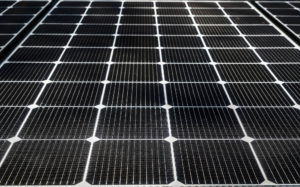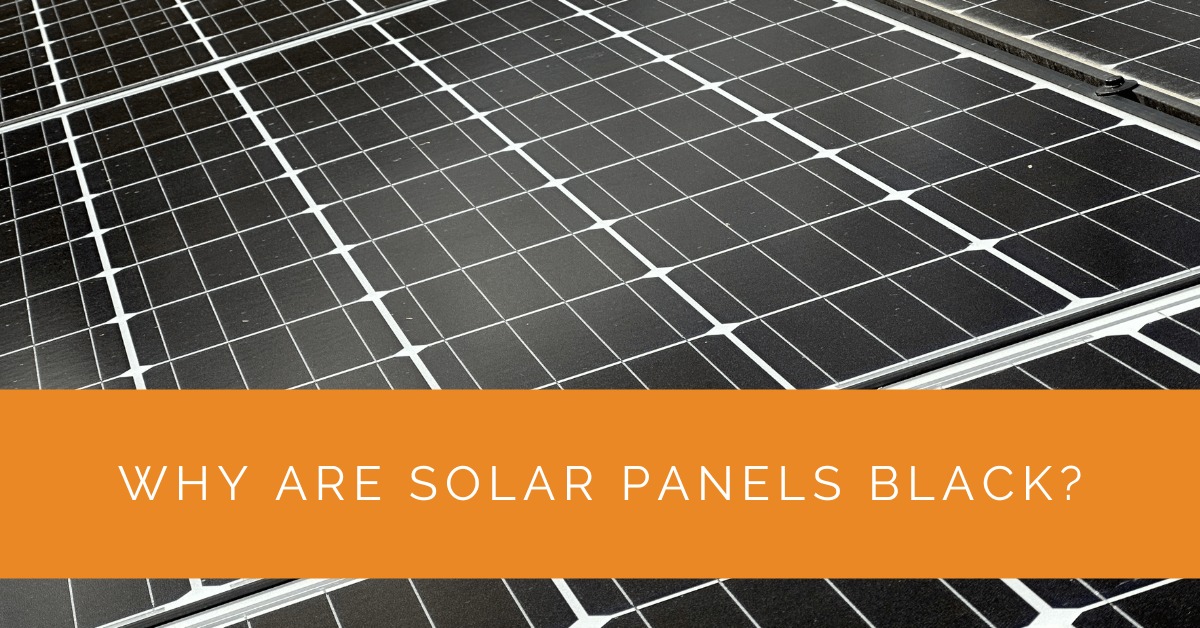Solar panels have revolutionized how we harness solar energy, providing an eco-friendly and sustainable solution for powering our homes. One distinctive feature that catches our eye is the color of solar panels, with black being the most common. Have you ever wondered why solar panels are predominantly black? In this article, we will explore the science and aesthetics behind the color of solar panels, comparing the advantages of black and blue panels and helping you make an informed decision when considering solar power for your home.
Contents
- 1 Key Takeaways
- 2 The Science Behind Solar Panels
- 3 Why Are Solar Panels Black?
- 4 Choosing the Best Solar Panels for Your Home
- 5 Case Study: Maximizing Efficiency with Black Solar Panels
- 6 Expert Insights From Our Solar Panel Installers About Why Solar Panels Are Black
- 7 Experience Solar Excellence with Us!
- 8 Conclusion
Key Takeaways
- Solar panels are predominantly black due to their visual appeal and ability to absorb sunlight efficiently across a broad spectrum, including ultraviolet and infrared rays.
- Black panels enhance energy conversion and maintain consistent electricity generation, even in low-light conditions, making them a popular choice for residential installations.
- While blue panels offer advantages, such as cost-effectiveness and a unique aesthetic, black monocrystalline panels generally provide higher efficiency and power output, making them ideal for maximizing energy generation in homes.
The Science Behind Solar Panels
To understand why solar panels are black, it’s important to grasp the basic principles behind their composition and functioning. Solar panels comprise numerous solar cells, also known as photovoltaic cells, which convert sunlight into electricity.
Solar Cell Composition
Solar cells are typically made of silicon, a highly abundant element known for its semiconducting properties. The most common types of silicon used in solar cells are monocrystalline and polycrystalline silicon.
Monocrystalline vs. Polycrystalline Solar Cells
Monocrystalline solar cells are created from a single crystal structure, producing a uniform and efficient panel. On the other hand, polycrystalline solar cells are composed of multiple silicon crystals, resulting in a less uniform appearance but still an effective energy converter.
Why Are Solar Panels Black?
One of the key factors contributing to the black color of solar panels is their visual aesthetic and ability to absorb sunlight effectively. Let’s explore the reasons behind their color choice and its advantages.
The Black Aesthetic
Black solar panels have become the industry standard due to their sleek and modern appearance. The monochromatic black color provides a visually pleasing integration when installed on rooftops or structures.
Absorption of Sunlight
Black panels are designed to maximize the absorption of sunlight. The dark color allows solar cells to capture a broader light spectrum, including ultraviolet (UV) and infrared (IR) rays. This enhanced light absorption results in improved energy conversion and overall panel efficiency.
Enhancing Efficiency
The color black is optimal for absorbing light, allowing solar panels to operate efficiently even in low-light conditions. This characteristic ensures that solar panels can generate electricity consistently, regardless of weather conditions or variations in sunlight intensity.
Black vs. Blue Solar Panels
While black panels dominate the market, blue solar panels have also gained popularity. Let’s compare the two to understand their differences and applications.
The Appeal of Blue Panels
Blue solar panels, often called blue modules, have a distinctive blue hue that sets them apart from their black counterparts. The blue color results from additional layers in the manufacturing process that help reduce the reflection of blue light, thereby increasing efficiency.
Differences in Material and Performance
Black panels, predominantly monocrystalline, are known for their higher efficiency rates and power output than blue panels, typically polycrystalline. Monocrystalline solar panels offer better performance in limited space and under higher temperatures.
Applications and Suitability
Black monocrystalline panels are an excellent choice for residential solar installations due to their higher efficiency and sleek appearance. On the other hand, blue polycrystalline panels may be a cost-effective option for larger installations where space is not a constraint.

Choosing the Best Solar Panels for Your Home
When deciding between black and blue solar panels for your home, several factors come into play. Consider the following aspects to make an informed decision:
Efficiency and Power Output
Black monocrystalline panels have higher efficiency rates and power output, making them ideal for homeowners looking to maximize their electricity generation. However, it’s important to assess your energy needs and available space. Monocrystalline panels may be the best choice if you have limited roof space or live in an area with ample sunlight. On the other hand, if cost-effectiveness is a priority and you have sufficient space, polycrystalline panels can be a viable option.
Cost and Affordability
When considering solar panel options, evaluating each type’s cost and affordability is crucial. Generally, polycrystalline panels are more budget-friendly compared to monocrystalline panels. If upfront cost is a significant concern, polycrystalline panels may be suitable. However, it’s important to note that monocrystalline panels may offer better long-term value due to their higher efficiency and power output.
Aesthetics and Design Considerations
The visual integration of solar panels into your home’s design is another aspect to consider. Black monocrystalline panels often blend seamlessly with most roof types and architectural styles, providing an aesthetically pleasing appearance. Blue polycrystalline panels, with their unique color, can also add a distinct visual element to your home. Consider your personal preferences and the overall aesthetic impact when selecting solar panels.
Environmental Impact
Both black and blue solar panels contribute to reducing carbon emissions and promoting sustainable energy practices. By generating clean electricity from sunlight, you can significantly reduce your carbon footprint and contribute to a greener environment. When choosing between black and blue panels, consider each option’s overall environmental impact and sustainability.
Case Study: Maximizing Efficiency with Black Solar Panels
Background
Solar Panels Network USA has been at the forefront of providing sustainable energy solutions to homeowners across the country. Our mission is to deliver high-quality solar installations that not only meet but exceed our customers’ energy needs. In this case study, we explore a recent project where we installed black monocrystalline solar panels to maximize energy efficiency for a residential property.
Project Overview
A homeowner approached us with the goal of significantly reducing their electricity bills and minimizing their carbon footprint. The client was particularly interested in the visual appeal and efficiency of black solar panels. After a thorough assessment of their energy needs and roof space, we proposed installing high-efficiency black monocrystalline solar panels.
Implementation
The implementation process began with a detailed site survey to determine the optimal placement of the panels for maximum sunlight exposure. Using advanced modeling software, we mapped out the best configuration to ensure efficient energy capture throughout the day.
- Panel Selection: We selected high-quality black monocrystalline panels known for their superior efficiency and sleek appearance.
- Installation: Our experienced team installed the panels, ensuring they were securely mounted and positioned at the optimal angle for maximum sunlight absorption.
- System Integration: The solar panels were integrated with a state-of-the-art inverter and monitoring system, allowing the homeowner to track energy production in real-time.
Results
The results of the project were remarkable. The black monocrystalline panels provided exceptional energy efficiency, significantly reducing the homeowner’s electricity bills. The panels’ ability to absorb a broad spectrum of light, including UV and IR rays, ensured consistent energy production, even on cloudy days. The sleek, black appearance of the panels also enhanced the overall aesthetic of the property, seamlessly blending with the roof’s design.
Summary
This project demonstrated the clear advantages of using black monocrystalline solar panels for residential installations. The panels’ superior light absorption and efficiency, combined with their modern aesthetic, made them an ideal choice for the homeowner. By opting for these high-efficiency panels, the homeowner not only achieved significant cost savings but also contributed to a more sustainable future.
At Solar Panels Network USA, we continue to leverage our expertise to deliver customized solar solutions that meet the unique needs of each client. Whether it’s maximizing energy efficiency or enhancing the visual appeal of a property, our commitment to excellence ensures that our customers receive the best possible outcomes.
Expert Insights From Our Solar Panel Installers About Why Solar Panels Are Black
As a senior solar installer, I can attest to the efficiency gains provided by black solar panels. Their ability to absorb a broader spectrum of light, including UV and IR rays, significantly enhances their performance, especially in diverse weather conditions.
Senior Solar Installer
Homeowners often ask about the color of their solar panels. From my experience, black panels not only look sleek but also provide higher energy conversion rates due to their superior light absorption properties.
Lead Solar Technician
Choosing black solar panels can be a game-changer for residential installations. Their modern aesthetic and higher efficiency make them a popular choice for those looking to maximize their solar investment.
Chief Solar Engineer
Experience Solar Excellence with Us!
Trust in Solar Panels Network USA, where our seasoned experts deliver top-quality solar solutions for homes and businesses nationwide. With a legacy of countless successful installations and a commitment to sustainable energy, we’re your reliable partner in the solar journey. Ready for a brighter, eco-friendly future? Call us now at (855) 427-0058 and harness the power of the sun!
Conclusion
The color of solar panels, whether black or blue, serves a purpose beyond mere aesthetics. With their superior light absorption and sleek appearance, black panels are widely preferred for residential solar installations. Monocrystalline black panels, in particular, offer higher efficiency and power output, making them an ideal choice for maximizing energy generation.
However, blue polycrystalline panels have advantages, such as cost-effectiveness and unique visual appeal. They can be suitable for larger installations or situations where upfront cost is a primary concern.
When selecting solar panels for your home, consider efficiency, cost, aesthetics, and environmental impact. By assessing your energy needs, available space, and budget, you can make an informed decision that aligns with your goals of going solar.
Remember, regardless of the color you choose, embracing solar power is a significant step towards a more sustainable and environmentally friendly future. Install solar panels and harness the power of the sun to create clean, renewable energy for your home.
About the Author
Solar Panels Network USA stands at the forefront of solar energy solutions, driven by a team of seasoned solar engineers and energy consultants. With over decades of experience in delivering high-quality solar installations and maintenance, we are committed to promoting sustainable energy through customer-centric, tailored solutions. Our articles reflect this commitment, crafted collaboratively by experts to provide accurate, up-to-date insights into solar technology, ensuring our readers are well-informed and empowered in their solar energy decisions.

